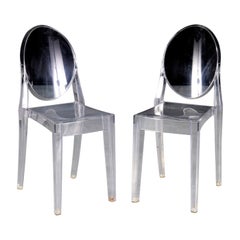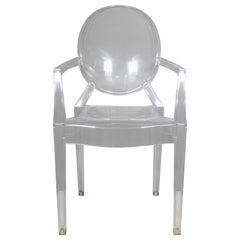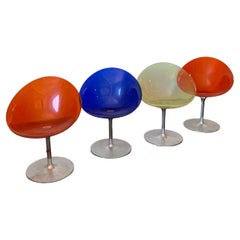Philippe Starck Acrylic Chair
Early 2000s Italian Organic Modern Chairs
Chrome
Early 2000s Italian Modern Chairs
Acrylic
21st Century and Contemporary Italian Post-Modern Dining Room Chairs
Acrylic
Recent Sales
Late 20th Century Italian Space Age Chairs
Metal
20th Century American Modern Chairs
Acrylic
21st Century and Contemporary Chairs
Acrylic
20th Century Italian Chairs
Acrylic
Late 20th Century Italian Chairs
Aluminum
Late 20th Century Italian Modern Swivel Chairs
Aluminum
Late 20th Century Italian Chairs
Aluminum
Late 20th Century Italian Chairs
Aluminum
Vintage 1970s Italian Mid-Century Modern Dining Room Chairs
Acrylic
21st Century and Contemporary Italian Modern Chairs
Acrylic
Late 20th Century Italian Modern Chairs
Lucite
Vintage 1970s Mid-Century Modern Chairs
Vintage 1980s American Mid-Century Modern Dining Room Chairs
Acrylic, Lucite
Vintage 1970s American Mid-Century Modern Dining Room Chairs
Acrylic, Lucite
Vintage 1980s Italian Modern Chairs
Metal
Late 20th Century Italian Chairs
Aluminum
Late 20th Century Italian Chairs
Aluminum
21st Century and Contemporary American Mid-Century Modern Dining Room Ch...
Acrylic, Lucite
21st Century and Contemporary Chinese Modern Chairs
Shagreen, Acrylic
Late 20th Century Italian Dining Room Chairs
Aluminum
1990s Post-Modern Office Chairs and Desk Chairs
Steel
People Also Browsed
21st Century and Contemporary Italian Modern Dining Room Chairs
Plastic
21st Century and Contemporary Italian Modern Dining Room Chairs
Plastic
Philippe Starck Acrylic Chair For Sale on 1stDibs
How Much is a Philippe Starck Acrylic Chair?
Materials: Plastic Furniture
Arguably the world’s most ubiquitous man-made material, plastic has impacted nearly every industry. In contemporary spaces, new and vintage plastic furniture is quite popular and its use pairs well with a range of design styles.
From the Italian lighting artisans at Fontana Arte to venturesome Scandinavian modernists such as Verner Panton, who created groundbreaking interiors as much as he did seating — see his revolutionary Panton chair — to contemporary multidisciplinary artists like Faye Toogood, furniture designers have been pushing the boundaries of plastic forever.
When The Graduate's Mr. McGuire proclaimed, “There’s a great future in plastics,” it was more than a laugh line. The iconic quote is an allusion both to society’s reliance on and its love affair with plastic. Before the material became an integral part of our lives — used in everything from clothing to storage to beauty and beyond — people relied on earthly elements for manufacturing, a process as time-consuming as it was costly.
Soon after American inventor John Wesley Hyatt created celluloid, which could mimic luxury products like tortoiseshell and ivory, production hit fever pitch, and the floodgates opened for others to explore plastic’s full potential. The material altered the history of design — mid-century modern legends Charles and Ray Eames, Joe Colombo and Eero Saarinen regularly experimented with plastics in the development of tables and chairs, and today plastic furnishings and decorative objects are seen as often indoors as they are outside.
Find vintage plastic lounge chairs, outdoor furniture, lighting and more on 1stDibs.
Finding the Right Seating for You
With entire areas of our homes reserved for “sitting rooms,” the value of quality antique and vintage seating cannot be overstated.
Fortunately, the design of side chairs, armchairs and other lounge furniture — since what were, quite literally, the early perches of our ancestors — has evolved considerably.
Among the earliest standard seating furniture were stools. Egyptian stools, for example, designed for one person with no seat back, were x-shaped and typically folded to be tucked away. These rudimentary chairs informed the design of Greek and Roman stools, all of which were a long way from Sori Yanagi's Butterfly stool or Alvar Aalto's Stool 60. In the 18th century and earlier, seats with backs and armrests were largely reserved for high nobility.
The seating of today is more inclusive but the style and placement of chairs can still make a statement. Antique desk chairs and armchairs designed in the style of Louis XV, which eventually included painted furniture and were often made of rare woods, feature prominently curved legs as well as Chinese themes and varied ornaments. Much like the thrones of fairy tales and the regency, elegant lounges crafted in the Louis XV style convey wealth and prestige. In the kitchen, the dining chair placed at the head of the table is typically reserved for the head of the household or a revered guest.
Of course, with luxurious vintage or antique furnishings, every chair can seem like the best seat in the house. Whether your preference is stretching out on a plush sofa, such as the Serpentine, designed by Vladimir Kagan, or cozying up in a vintage wingback chair, there is likely to be a comfy classic or contemporary gem for you on 1stDibs.
With respect to the latest obsessions in design, cane seating has been cropping up everywhere, from sleek armchairs to lounge chairs, while bouclé fabric, a staple of modern furniture design, can be seen in mid-century modern, Scandinavian modern and Hollywood Regency furniture styles.
Admirers of the sophisticated craftsmanship and dark woods frequently associated with mid-century modern seating can find timeless furnishings in our expansive collection of lounge chairs, dining chairs and other items — whether they’re vintage editions or alluring official reproductions of iconic designs from the likes of Hans Wegner or from Charles and Ray Eames. Shop our inventory of Egg chairs, designed in 1958 by Arne Jacobsen, the Florence Knoll lounge chair and more.
No matter your style, the collection of unique chairs, sofas and other seating on 1stDibs is surely worthy of a standing ovation.
- 1stDibs ExpertApril 5, 2022Philippe Starck designed the Ghost chair for the furniture maker Kartell to produce and sell in 2002. It draws inspiration from the Louis XVI upholstered armchair. You'll find a collection of Philippe Starck Ghost chairs from some of the world’s top sellers on 1stDibs.
- 1stDibs ExpertApril 5, 2022The Louis Ghost chair is made of clear or tinted polycarbonate, a durable, yet lightweight type of thermoplastic polymer. Phillipe Stark designed the chair in 2002, drawing inspiration from traditional Louis XVI armchairs. Shop a selection of Phillipe Stark Ghost chairs on 1stDibs.
Read More
All the Furniture in This Organic Modern Soho Loft Can Be Yours
Andrianna Shamaris has filled her epic new home with pieces of her own design.
20 Inviting Dining Rooms Perfectly Arranged for Entertaining
Top interior designers show — and tell — us how to create delectable spaces for hosting dinner parties.
Nobody Puts This Sunny Sofa in a Corner
With its plush cushions, cane details and dazzlingly colorful back, it’s inviting from every angle.
The 21 Most Popular Mid-Century Modern Chairs
You know the designs, now get the stories about how they came to be.
Fred Rigby’s Modular Seating Can Be Configured in So Many Handy Ways
The plush Cove Slipper 2.5 Seater sofa is just one of many convenient combinations from the London-based maker.
This Chubby-Chic Quilted Stool Stands on Its Own Two Feet
Sam Klemick's cool stool is edgy, cozy and environmentally sustainable all at once.
Is Lionel Jadot the Willy Wonka of Upcycled Belgian Design?
From his massive collaborative workshop in a former paper factory, the designer concocts funky furniture from disused materials, as well as luxe hotel interiors like the new Mix Brussels.
Rock Your Cares Away on This Sunny Hand-Crocheted Swing
The boho-chic Enchanted Forest Swing, handmade by marginalized women from Turkey and Syria, is uplifting in every way.




